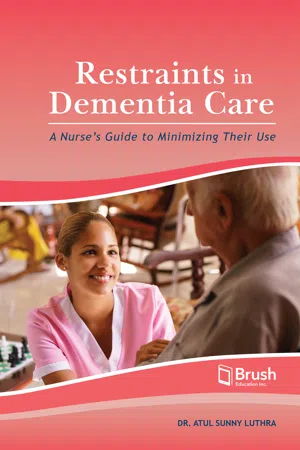
Restraints in Dementia Care
A Nurse's Guide to Minimizing Their Use
- 96 pages
- English
- ePUB (mobile friendly)
- Available on iOS & Android
Restraints in Dementia Care
A Nurse's Guide to Minimizing Their Use
About this book
Your best tool to optimize patient care by minimizing restraint use
Frontline nurses face fraught decisions every day about whether and how to use restraints in dementia care. They need to consider many complicated issues: legislation governing the use of restraints, the policies of health-care facilities, the expectations of families, and—most importantly—the well-being, dignity, and safety of patients and care providers.
Frontline nurses need the right support to navigate decisions about restraint use.
Dr. Atul Sunny Luthra and his colleagues have developed an algorithm to provide that support. Their work comes from focus-group consultations with frontline staff, a review of current literature on restraint use, and a clear summary of key legislation. The algorithm's systematic approach ensures restraints are a last-resort measure, and puts the right steps in place when restraints are necessary.
This short guide includes:
- A review of nurses' perspectives on restraint use.
- Alternatives to restraints in patient management and assessment of clinical indicators for restraint use.
- Procedures to ensure informed consent when restraints are necessary.
- A reference on appropriate and inappropriate restraint use in everyday clinical situations.
Frequently asked questions
- Essential is ideal for learners and professionals who enjoy exploring a wide range of subjects. Access the Essential Library with 800,000+ trusted titles and best-sellers across business, personal growth, and the humanities. Includes unlimited reading time and Standard Read Aloud voice.
- Complete: Perfect for advanced learners and researchers needing full, unrestricted access. Unlock 1.4M+ books across hundreds of subjects, including academic and specialized titles. The Complete Plan also includes advanced features like Premium Read Aloud and Research Assistant.
Please note we cannot support devices running on iOS 13 and Android 7 or earlier. Learn more about using the app.
Information
1 Five Clinical Scenarios Perspectives on Restraint use from Frontline Staff at Homewood Health Centre
Clinical Scenario 1
Clinical Scenario 2
Clinical Scenario 3
Clinical Scenario 4
Clinical Scenario 5
A Closer Analysis of the Clinical Scenarios
Table of contents
- Cover
- Title Page
- Contents
- Acknowledgements
- Introduction
- 1 Five Clinical Scenarios: Perspectives on Restraint Use from Frontline Staff at Homewood Health Centre
- 2 Nurses’ perceptions of Restraint Use: A Literature Review
- 3 Clinical Indicators for Restraint Use: A Literature Review
- 4 The Law and Restraint Use
- 5 Obtaining Informed Consent for Restraint Use
- 6 A Decision-making Algorithm for Restraint Use in Dementia Care
- 7 A Reference on Appropriate Restraint Use
- References
- About the Authors
- Copyright